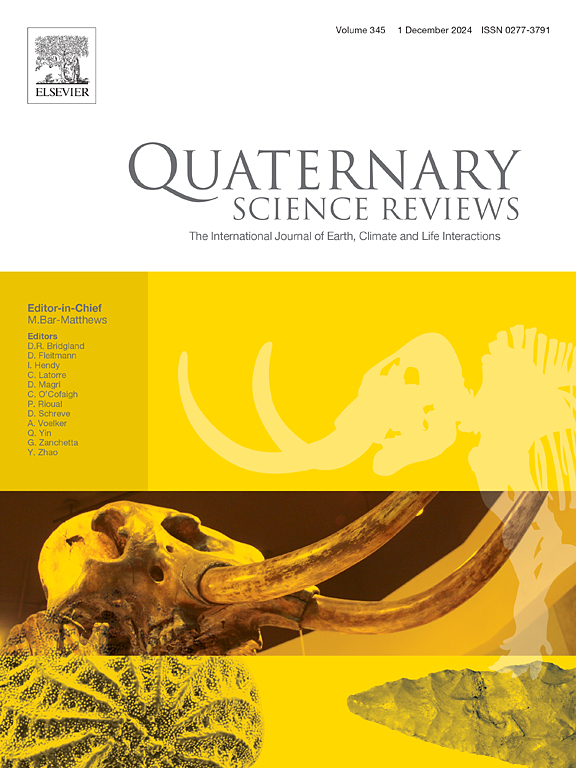末次盛冰期以来西安纳托利亚(土耳其)环境史
IF 3.2
1区 地球科学
Q1 GEOGRAPHY, PHYSICAL
引用次数: 0
摘要
在数千年的时间尺度上,气候、土地利用和火灾之间复杂的相互作用塑造了地中海景观。了解过去的变化轨迹可以提供现代景观如何出现的知识,这对它们的可持续管理是有价值的。本研究的目的是利用高分辨率和多代理数据集,通过对末次盛冰期(LGM)至今的Buldan Yayla湖(Denizli-Buldan)沉积物的古生态分析,重建安纳托利亚西部(土耳其)的环境变化。为此,对Buldan Yayla湖(Denizli-Buldan)沉积物岩心进行了化石花粉、微炭、非花粉孢粉形态、微(μ)-XRF和放射性碳分析。根据化石花粉记录,在LGM时期(21000 ~ 18000 cal. BP),森林的存在率较低,由于气候条件寒冷干燥,这一时期森林的存在率最低,为5%。随着向后lgm时期的过渡,森林的存在开始增加。从湖泊记录到全新世晚期,森林发育迅速,森林覆盖率高。根据为这一记录开发的年龄深度模型,安纳托利亚西部的森林发展比欧洲早了大约4000年,尽管如果存在中断,这可能反映出至少1300年的转变。在9250 ~ 8900和7700 cal. BP的干燥气候时期,晚冰期的高森林丰度被中断。全新世晚期以集约土地利用为特征,特别是橄榄种植,在罗马帝国时期(Tripolis古城时代)达到最高水平,安纳托利亚的橄榄比例最高(38.4%)。森林通常以橡树为主,在过去的1350 (cal. BP)年,松林取代了橡树林。微炭和非花粉孢粉形态资料在LGM -全新世之间浓度较低,随着全新世过渡开始增加,在全新世晚期达到最高值。本研究重建了西安纳托利亚的长期环境变化,揭示了气候变率与植被格局变化之间的重要关系,特别强调了在某些时期火灾频率的增加和土地利用的变化。这一发现为理解地中海盆地气候、植被、火灾和土地利用之间的关系提供了一个重要的例子。本文章由计算机程序翻译,如有差异,请以英文原文为准。
Environmental history in Western Anatolia (Turkey) since the Last Glacial Maximum
Mediterranean landscapes have been shaped by complex interactions between climate, land use and fire over multi-millennial timescales. Understanding past trajectories of change provides knowledge of how modern landscapes emerged, which can be valuable for their sustainable management. The aim of this study is to reconstruct environmental change in Western Anatolia (Turkey) through palaeoecological analysis of sediment from Buldan Yayla Lake (Denizli-Buldan) from the Last Glacial Maximum (LGM) to the present, using a high-resolution and multi-proxy dataset. To this end, fossil pollen, micro-charcoal, non-pollen palynomorphs, micro (μ)-XRF and radiocarbon analyses were applied to an ∼18 m sediment core from Buldan Yayla Lake (Denizli-Buldan). According to the fossil pollen record, forest presence was low during the LGM (21000-18000 cal. BP), with the lowest value recorded at 5 % during this period due to cold and dry climatic condition. Forest presence began to increase with the transition to the Post-LGM period. Rapid forest development and high forest presence were observed in the lake record from the transition to the LGM until the late Holocene. Forest development in Western Anatolia occurred approximately 4,000 years earlier than in Europe according to the age-depth model developed for this record, though if a hiatus exists, this could reflect a shift of at least 1,300 years. High forest abundance during the late Glacial period was interrupted during the Younger Dryas (YD) and during the dry climatic periods of 9250–8900 and 7700 cal. BP. The late Holocene period was characterized by intensive land use, specifically olive cultivation, which reached its highest level in the Roman Imperial Period (during the ancient city of Tripolis era), and the highest olive percentage recorded in Anatolia (38.4 %) was reached. Forests were generally dominated by oaks, with pine forests replacing oak forests in the last 1350 (cal. BP) years. Micro-charcoal and non-pollen palynomorph data were low in concentration between the LGM and Holocene and began to increase with the Holocene transition reaching their highest values during the late Holocene. This study provides a reconstruction of long-term environmental change in Western Anatolia and reveals a significant relationship between climate variability and shifts in vegetation patterns, particularly highlighting the increasing frequency of fires and changes in land use during certain periods. This finding serves as an important example for understanding the relationships between climate, vegetation, fire, and land use in the Mediterranean Basin.
求助全文
通过发布文献求助,成功后即可免费获取论文全文。
去求助
来源期刊

Quaternary Science Reviews
地学-地球科学综合
CiteScore
7.50
自引率
15.00%
发文量
388
审稿时长
3 months
期刊介绍:
Quaternary Science Reviews caters for all aspects of Quaternary science, and includes, for example, geology, geomorphology, geography, archaeology, soil science, palaeobotany, palaeontology, palaeoclimatology and the full range of applicable dating methods. The dividing line between what constitutes the review paper and one which contains new original data is not easy to establish, so QSR also publishes papers with new data especially if these perform a review function. All the Quaternary sciences are changing rapidly and subject to re-evaluation as the pace of discovery quickens; thus the diverse but comprehensive role of Quaternary Science Reviews keeps readers abreast of the wider issues relating to new developments in the field.
 求助内容:
求助内容: 应助结果提醒方式:
应助结果提醒方式:


